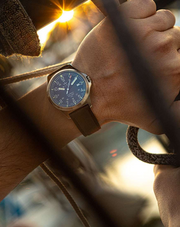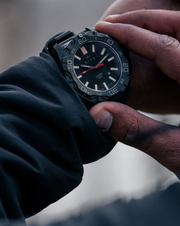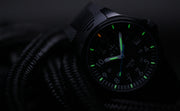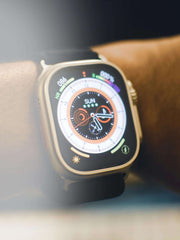Key Takeaways
- Origins in the Trenches - Field watches evolved from WWI trench warfare when pocket watches proved impractical for combat
- Essential Features - Maximum readability, robust construction, and reliable timekeeping define true field watches
- Military Heritage - WWII established formal military specifications that still influence modern designs
- Modern Innovation - Swiss quartz technology offers superior accuracy and reliability over mechanical alternatives
- Tritium Technology - Self-powered illumination provides 20+ years of continuous glow without charging
- Best Field Watch Features - Quality brands focus on proven performance over marketing hype
- Professional Choice - Proven military heritage and tritium illumination make NITE the preferred choice
- MX10 Heritage - NATO-certified and UK Special Forces adopted, proving genuine military performance
What Defines a Field Watch?
A field watch is essentially a military timepiece designed to be read quickly and survive tough conditions. Think of it as the Land Rover of watches: built for purpose, not for show. These watches were originally created for soldiers in World War I who needed to check time whilst fighting, and they've evolved into some of the most practical timepieces you can buy today.
What makes a field watch different from other watches? Three things really matter: you can read them instantly even in poor light, they're tough enough to handle whatever you throw at them, and they keep accurate time without fuss. Unlike fancy dress watches or chunky dive watches, field watches focus on one job: telling time clearly when it really counts.
Modern field watches have come a long way from their wartime origins. The best ones today, like those from NITE Watches, blend authentic military looks with modern technology. We're talking Swiss quartz movements that are incredibly accurate and tritium illumination that glows constantly in the dark without needing any charging. It's not about abandoning tradition, it's about making these watches even better at what they've always done best.
Origins in the Trenches: World War I Necessity
The story of field watches starts in the muddy trenches of World War I, where soldiers quickly discovered that pocket watches were useless for modern warfare. British officers faced a simple but deadly problem: they needed to check the time quickly whilst holding a rifle and coordinating attacks, but digging out a pocket watch took too long and could get them killed.
The solution was brilliantly simple. Officers started strapping their pocket watches to their wrists using leather straps or even bits of wire. These makeshift "trench watches" weren't pretty, but they worked. Suddenly, checking time became a quick glance rather than a fumbling search through pockets.
This change was bigger than just convenience. When officers could check time instantly, they could coordinate attacks properly. Artillery strikes needed perfect timing, otherwise you'd hit your own troops or miss the target entirely. Those few seconds saved by having the watch on your wrist often meant the difference between mission success and disaster.
In reality, field watches were born from necessity, not clever design. Trench warfare was brutal, and watches needed to work when covered in mud, survive explosions, and stay readable even when wearing a gas mask. These harsh conditions created the basic rules that still define proper field watches today: they must be easy to read, tough as nails, and reliable no matter what.
WWII Standardisation: Military Watches Get Serious
World War II changed everything for field watches. Instead of soldiers improvising with whatever they could find, the military started setting proper standards for what these watches should be. The Americans created the A-11 specification in 1940, which was basically a rulebook for making proper military watches.
The American specification was quite specific: watches needed reliable movements that could stop the second hand for synchronisation, black dials with white numbers that you could read instantly, and 24-hour markings for military time. American heritage brands started making thousands of these standardised watches for troops fighting everywhere from tropical Pacific islands to freezing European battlefields.
The British did things slightly differently with their "Wrist Watch Waterproof" specification, commissioning twelve companies to make what collectors now call "The Dirty Dozen". These British military watches featured small seconds dials at 6 o'clock and better water resistance for beach landings.
These wartime standards created the template that still influences field watches today. The clean dial layouts, contrast between black and white, and tough construction all trace back to WWII requirements. Modern field watches like NITE's MX10 collection follow these same principles but with much better technology, giving you the authentic military look with reliability that those wartime watches could never match.
Why Field Watches Are So Easy to Read
The whole point of a field watch is that you can read it instantly, even when you're stressed, tired, or in poor light. Everything about the design focuses on making the time as clear as possible. You'll notice field watches typically have black dials with big white numbers, simple hands, and no fancy complications that might confuse you when you need to know the time quickly.
Think about it from a soldier's perspective: if you're trying to coordinate with your team or time something important, you can't afford to squint at tiny numbers or elegant Roman numerals. You need to glance at your wrist and immediately know what time it is. That's why field watches use large Arabic numbers (1, 2, 3 instead of I, II, III) and high contrast between the dial and markings.
NITE's approach to dial design really gets this right. Their watches use bold, clear numbers and smart colour choices that make time reading effortless. The hands are shaped so you can distinguish them immediately, and there's nothing unnecessary cluttering up the dial.
The 24-hour markings around the edge are another practical touch inherited from military use. Military time runs on a 24-hour clock (so 2pm becomes 14:00), and having those numbers right there means you don't need to do mental maths to convert between formats. It's these practical details that separate authentic field watches from regular watches that just happen to look military.
Built to Take a Beating: Field Watch Toughness
Field watches need to survive things that would destroy normal watches. We're talking about getting dropped, banged against rocks, soaked in rain, frozen in winter, and baked in summer heat. The whole watch, from the case to the crystal to the movement inside, has to be designed to handle serious abuse and keep working.
The engineering that goes into making a watch this tough is quite impressive. Modern field watches use surgical-grade steel for the case, the same stuff used in medical implants because it doesn't corrode and it's incredibly strong. The crystal covering the dial isn't normal glass anymore but sapphire, which is nearly as hard as diamond and won't scratch easily.
The sealing is crucial too. Field watches have special gaskets and seals that keep water and dirt out, even when you're swimming or working in dusty conditions. What's remarkable is how much better modern field watches are compared to the vintage ones. Today's materials science and manufacturing techniques create watches that would have seemed impossible to those WWII soldiers.
Why Modern Field Watches Use Quartz Instead of Mechanical Movements
Most vintage field watches used mechanical movements, the kind with gears and springs that you need to wind up. But the best modern field watches, including NITE's entire range, use quartz movements instead. There's a very good reason for this.
Quartz movements are simply more accurate and reliable. A good Swiss quartz movement might be off by 15 seconds in a whole month, whilst even the best mechanical movement can vary by 30 seconds in a single day. For military or professional use, that accuracy difference really matters when you're timing important operations.
There's also the maintenance factor. With a quartz watch, you change the battery every few years and that's it. Mechanical watches need complete servicing every 3-5 years, which is expensive and means you're without your watch for weeks. Quartz movements also handle shocks and temperature changes better than delicate mechanical parts.
NITE's commitment to Swiss quartz reflects their understanding that field watches are tools first and fashion statements second. They use carefully selected Swiss movements that prioritise reliability and accuracy over complications. Actually, it's about making watches that work better, not just preserving tradition for its own sake.
Tritium Illumination: The Modern Advantage
One of the coolest features of proper modern field watches is tritium illumination, and it makes a huge difference in real use. Most watches with glow-in-the-dark features use paint that you need to "charge" by exposing it to light. Tritium is completely different - it glows constantly for decades without ever needing charging.
NITE uses professional-grade tritium tubes that provide constant visibility in complete darkness for over 20 years. No button-pushing, no light-charging required, just constant, reliable glow whenever you need it.
Modern Professional Applications
Field watches aren't just military history pieces. They're actively used by people who need reliable timekeeping in demanding jobs. Military personnel still rely on them, but you'll also find field watches on the wrists of police officers, firefighters, paramedics, outdoor guides, and industrial workers who need watches that won't let them down.
Today's military operations need watches that go beyond traditional field watch specs. We're talking GPS that works properly, night vision that doesn't interfere with your equipment, chemical resistance for nasty environments, and temperature stability from Arctic cold to desert heat. Professional civilian roles have expanded well beyond traditional military use too.
The appeal extends to civilian life as well. If you're into hiking, camping, or any outdoor activities, a field watch makes perfect sense. They're also great for everyday wear if you prefer practical, no-nonsense watches that focus on function over flash. The clean, simple design works well whether you're in work clothes or casual gear.
NITE offers various collections that serve all these different users through designs that balance authentic military heritage with modern performance.
Choosing the Best Field Watch: What to Look For
When you're researching the best field watches available today, a few things really matter when separating quality options from marketing hype. Quality field watch makers concentrate on proven reliability rather than flashy features or lifestyle marketing. Traditional American heritage manufacturers offer entry-level options, whilst European tactical watch brands create specialised military contracts and Japanese manufacturers produce robust alternatives.
NITE occupies the unique position of authentic military heritage combined with cutting-edge technology. Unlike mass-market brands using basic luminous paint, or expensive alternatives offering similar features at inflated prices, NITE delivers genuine military specification watches with advanced tritium technology at fair pricing.
The MX10: NITE's Military Heritage
The MX10 is where NITE made their reputation. This watch earned NATO certification and was actually adopted by UK Special Forces, which isn't marketing hype, it's genuine professional validation. Military units choose equipment based on performance, not brand names.
The MX10 features a 39mm steel case that fits most wrists comfortably, a Swiss quartz movement with 10-year battery life, 100m water resistance for all-weather reliability, and 15 tritium tubes for complete dial illumination. The integrated bracelet is designed for durability and comfort during extended wear.
What's genuinely impressive is the real-world feedback from professional users. Military personnel report years of trouble-free operation in harsh conditions, whilst civilian users including emergency workers and outdoor enthusiasts consistently praise its reliability and visibility. This isn't just about specs on paper, it's about proven performance where it really counts.
Frequently Asked Questions
- What makes a watch a "field watch" rather than just a military watch? Field watches focus specifically on clear time reading, tough construction, and reliable performance above everything else. While military watches might include various specialised functions, authentic field watches concentrate entirely on telling time clearly and reliably in tough conditions.
- Why do modern field watches use quartz movements instead of mechanical ones? Swiss quartz movements are simply more accurate and need much less maintenance. You change the battery every few years instead of servicing the whole watch every 3-5 years.
- How long does tritium illumination last, and is it safe? Tritium illumination glows continuously for 20-25 years without charging or external power. It's completely safe because the particles can't penetrate skin, and the sealed tubes prevent any gas exposure while providing constant visibility in complete darkness.
- What water resistance rating do I need for a field watch? Most field watch uses need 100m water resistance, which handles all-weather use, accidental dunking, and professional activities except serious diving. For underwater work, 200m+ ratings offer better protection.
- Are field watches suitable for everyday civilian wear? Modern field watches work brilliantly for everyday wear, especially if you value practical functionality over decorative features. Their tough construction, accurate timekeeping, and clear displays make them ideal for outdoor activities and daily wear.
- What's the difference between T25 and T100 tritium ratings? T25 tritium tubes provide controlled illumination that's bright enough to read clearly but subtle for tactical situations. T100 tubes offer maximum brightness for when visibility is your priority, being roughly four times brighter than T25.













